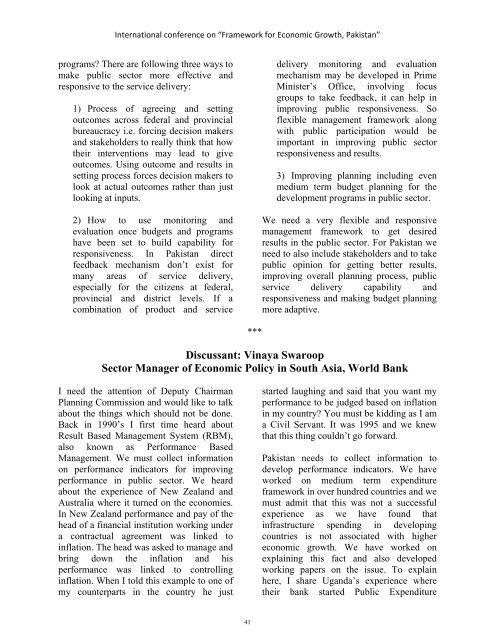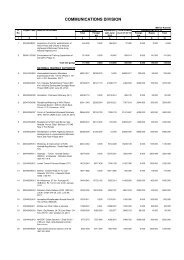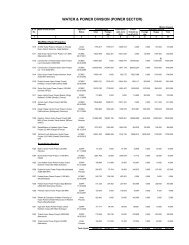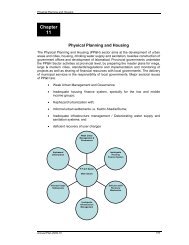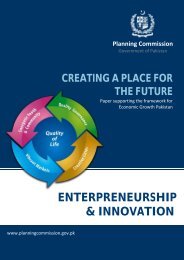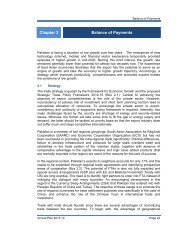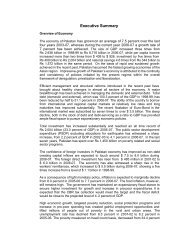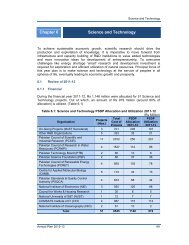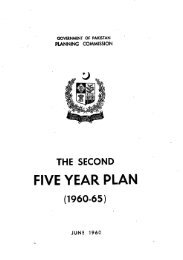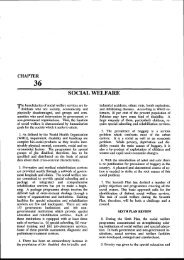Framework for Economic Growth, Pakistan - Planning Commission
Framework for Economic Growth, Pakistan - Planning Commission
Framework for Economic Growth, Pakistan - Planning Commission
You also want an ePaper? Increase the reach of your titles
YUMPU automatically turns print PDFs into web optimized ePapers that Google loves.
International conference on “<strong>Framework</strong> <strong>for</strong> <strong>Economic</strong> <strong>Growth</strong>, <strong>Pakistan</strong>”programs? There are following three ways tomake public sector more effective andresponsive to the service delivery:1) Process of agreeing and settingoutcomes across federal and provincialbureaucracy i.e. <strong>for</strong>cing decision makersand stakeholders to really think that howtheir interventions may lead to giveoutcomes. Using outcome and results insetting process <strong>for</strong>ces decision makers tolook at actual outcomes rather than justlooking at inputs.2) How to use monitoring andevaluation once budgets and programshave been set to build capability <strong>for</strong>responsiveness. In <strong>Pakistan</strong> directfeedback mechanism don’t exist <strong>for</strong>many areas of service delivery,especially <strong>for</strong> the citizens at federal,provincial and district levels. If acombination of product and servicedelivery monitoring and evaluationmechanism may be developed in PrimeMinister’s Office, involving focusgroups to take feedback, it can help inimproving public responsiveness. Soflexible management framework alongwith public participation would beimportant in improving public sectorresponsiveness and results.3) Improving planning including evenmedium term budget planning <strong>for</strong> thedevelopment programs in public sector.We need a very flexible and responsivemanagement framework to get desiredresults in the public sector. For <strong>Pakistan</strong> weneed to also include stakeholders and to takepublic opinion <strong>for</strong> getting better results,improving overall planning process, publicservice delivery capability andresponsiveness and making budget planningmore adaptive.***Discussant: Vinaya SwaroopSector Manager of <strong>Economic</strong> Policy in South Asia, World BankI need the attention of Deputy Chairman<strong>Planning</strong> <strong>Commission</strong> and would like to talkabout the things which should not be done.Back in 1990’s I first time heard aboutResult Based Management System (RBM),also known as Per<strong>for</strong>mance BasedManagement. We must collect in<strong>for</strong>mationon per<strong>for</strong>mance indicators <strong>for</strong> improvingper<strong>for</strong>mance in public sector. We heardabout the experience of New Zealand andAustralia where it turned on the economies.In New Zealand per<strong>for</strong>mance and pay of thehead of a financial institution working undera contractual agreement was linked toinflation. The head was asked to manage andbring down the inflation and hisper<strong>for</strong>mance was linked to controllinginflation. When I told this example to one ofmy counterparts in the country he juststarted laughing and said that you want myper<strong>for</strong>mance to be judged based on inflationin my country? You must be kidding as I ama Civil Servant. It was 1995 and we knewthat this thing couldn’t go <strong>for</strong>ward.<strong>Pakistan</strong> needs to collect in<strong>for</strong>mation todevelop per<strong>for</strong>mance indicators. We haveworked on medium term expenditureframework in over hundred countries and wemust admit that this was not a successfulexperience as we have found thatinfrastructure spending in developingcountries is not associated with highereconomic growth. We have worked onexplaining this fact and also developedworking papers on the issue. To explainhere, I share Uganda’s experience wheretheir bank started Public Expenditure41


